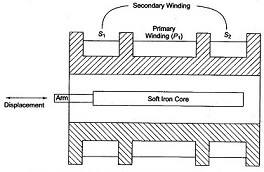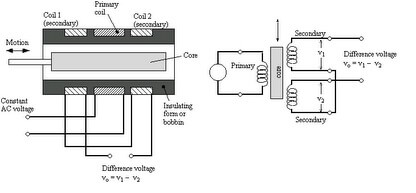Question
In: Electrical Engineering
Describe the principles and operations of distance sensor: potentiometer, linear variable differential transformer (LVDT), and optical...
Describe the principles and operations of distance sensor: potentiometer, linear variable differential transformer (LVDT), and optical encoder, state the advantage and disadvantage of each type of distance sensors.
Solutions
Expert Solution
Potentiometer:
Potentiometer is a resistive and passive transducer. It is consist of long uniform wire of manganin or constantan fixed parallel to one another connected in series by copper strips. A meter is fixed parallel to wires (each one meter) and two ends are fixed with binding screws. The potentiometer jockey can be touched to wire at any location. A battery E connected across A and B sends the current through the wire which is kept constant by using rheostat Rh.
Principle: The working of potentiometer is based upon the fact that fall of the potential across any portion of the wire is directly proportional to the length of the wire provided wire has uniform cross section area and constant current flowing through it.
Consider a length of wire l and current flowing through it is I. Cross section area is A and ρ is Resistivity and R is resistance. Then we can say potential across the wire length is
if I and A is constant then
V/l =K = constant, which also called potential gradient that is fall of potential per unit length of wire.
It is called potentiometer because it is used to measure potential difference.
Advantages of Potentiometer
Potentiometer is a null method device.At null point it does not draw any current from the cell and thus there is no potential drop due to the internal resistance of the cell.
It measures the potential difference in an open circuit which is equal to the actual emf of the cell.
While a voltmeter draws a small current from the cell for its operation.So it measures the terminal p.d. in a closed circuit which is less than the emf of a cell.That is why a potentiometer is preferred over a voltmeter for measuring the emf of a cell.
We can also measure any physical quantity that can produce or control a potential difference, using a potentiometer.
Disadvantage
The major disadvantage is that it requires a large force to move their sliding contacts i.e. wiper. There is wear and tear due to movement of the wiper. It reduces the life of this transducer.
LVDT Construction
LVDT comprises of a cylindrical former, which is bounded by one main winding in the hub of the former and the two minor LVDT windings are wound on the surfaces. The amount of twists in both the minor windings is equivalent, but they are reverse to each other like clockwise direction and anti-clockwise direction.

LVDT Construction
For this reason, the o/p voltages will be the variation in voltages among the two minor coils. These two coils are denoted with S1 & S2. Esteem iron core is located in the middle of the cylindrical former. The excitation voltage of AC is 5-12V and the operating frequency is given by 50 to 400 HZ.
Working Principle of LVDT
The working principle of the linear variable differential transformer or LVDT working theory is mutual induction. The dislocation is a nonelectrical energy that is changed into an electrical energy. And, how the energy is altered is discussed in detail in the working of an LVDT.

LVDT Working Principle
Working of an LVDT
The working of LVDT circuit diagram can be divided into three cases based on the position of the iron core in the insulated former.
- In Case-1: When the core of the LVDT is at the null location, then both the minor windings flux will equal, so the induced e.m.f is similar in the windings. So for no dislocation, the output value (eout) is zero because both the e1 & e2 are equivalent. Thus, it illustrates that no dislocation took place.
- In Case-2: When the core of the LVDT is shifted to up to the null point. In this case, the flux involving with minor winding S1 is additional as contrasted to flux connecting with the S 2 winding. Due to this reason, e1 will be added as that of e2. Due to this eout (output voltage) is positive.
- In Case-3: When the core of the LVDT is shifted down to the null point, In this case, the amount of e2 will be added as that of e1. Due to this eout output voltage will be negative plus it illustrates the o/p to down on the location point.
Advantages and Disadvantages of LVDT
-
The LVDT advantages and disadvantages include the following.
- The measurement of the displacement range of LVDT is very high, and it ranges from 1.25 mm -250 mm.
- The LVDT output is very high, and it doesn’t require any extension. It owns a high compassion which is normally about 40V/mm.
- When the core travels within a hollow former consequently there is no failure of displacement input while frictional loss so it makes an LVDT as a very precise device.
- LVDT demonstrates a small hysteresis and thus repetition is exceptional in all situations
- The power consumption of the LVDT is very low which is about 1W as evaluated by another type of transducers.
- LVDT changes the linear dislocation into an electrical voltage which is simple to progress.
- LVDT is responsive to move away from magnetic fields, thus it constantly needs a system to keep them from drift magnetic fields.
- It is accomplished that LVDTs are more beneficial as contrasted than any kind of inductive transducer.
- LVDT gets damaged by temperature as well as vibrations.
Optical encoder
An optical encoder is an electromechanical device that uses a light source, light detectors and an optical grating to convert angular position or motion to an electrical signal.

With optical encoders, a light source shines light onto or through a grating (usually a glass or plastic disk) which is marked so that the light passes through or is blocked. The optical detector(s) sense the light’s passage and generate a corresponding electrical pulse.
Strengths of an optical encoder
| High resolution; high accuracy; high repeatability; compact; moderate alignment tolerances |
| Weaknesses of an optical encoder |
| Environmental ruggedness. |
Related Solutions
Do a PowerPoint contain 6 to 8 slideshow about linear variable differential transformer. It introduces the...
Describe the principles and operations of movement sensors: Doppler-Effect Velocity sensor and Spring-Mass Accelerometor; State the...
Describe the principles and operations of a Solenoid and a Relay; State the difference between a...
Describe the principles and operations of proximity sensors: Inductive, Capacitive, and Photoelectric. State the advantage and...
Describe the principles and operations of four types of concentrating solar power (CSP) technologies using a...
- Convert into pseudo-code for below code =============================================== class Main { public static void main(String args[])...
- If the density of the universe great than a critical value, then it might continue expanding...
- A 16.4-kg block rests on a horizontal table and is attached to one end of a...
- Freud’s theory of defense mechanisms has had a profound impact on the methods used by therapist,...
- discuss what a disclaimer is, when is it is issued, and how it would affect the...
- Explain why 1 additional net ATP is produced when the beginning substrate is glycogen compared to...
- What is Sales Tax, its salient features and how it works, do a comparative analysis between...
 Manojponduru answered 1 year ago
Manojponduru answered 1 year ago